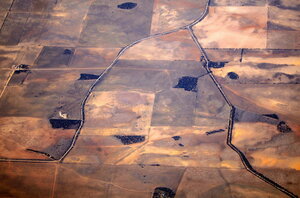Could the Earth be getting greener? Satellite data say yes.
A study of satellite data has found that terrestrial vegetation has increased lately.

Roads can be seen intersecting drought-affected farming areas located in south-eastern Australia March 21, 2015. A report titled 'Thirsty Country: Climate change and drought in Australia' by the Australian research body the Climate Council, has argued in its latest paper that the probability of drought will increase, and it will become more severe, because of climate change. The crowdfunded body claimed that since the mid-1990s rainfall in southeast Australia had declined between 15 and 20 per cent, and due to a warming climate, rain across southern Australia had "shifted" further south increasing the risk of drought in south-east and south-west Australia.
David Gray/Reuters
Despite decades of deforestation and environmental damage, a recent study published in Nature Climate Change found that, lately, the Earth has been getting a bit greener.
Researchers Yi Liu, Albert Van Dijk, and Pep Canadell discovered that between 2003 and 2012, the amount of vegetation above ground increased by 4 billion metric tons of carbon.
The new vegetation was mapped over a period of two decades using a method called passive microwave remote sensing, in which satellites measure radiofrequency radiation emitted from the Earth. Just about everything emits a small amounts of electromagnetic radiation in the same frequencies as radio waves, and these emissions carry information about the temperature and moisture content of the object emitting it. Using this data, scientists are able to tell what is and what isn't vegetation.
“We extracted this vegetation information from several satellites and merged them into one time series covering the last two decades,” Liu, Van Dijk and Canadell wrote in The Conversation. “This allowed us to track global changes in biomass from month to month, something that was not possible before.”
The study showed improvement particularly in former Soviet nations, where forests have gradually grown on abandoned farmland; in China, which has implemented massive tree planting campaigns; and arid areas like the savannas of Africa, Australia, and South America.
The increase of vegetation in the savannas was most surprising to the researchers, but also not as promising.
"Savannas and shrublands are vulnerable to rainfall – one year can be very wet, and more carbon will be fixed in plants, but the next year can be very dry, and then we will lose the carbon fixed in previous years," Liu told Reuters.
This new growth offsets nearly half of the carbon loss due to deforestation in the Amazon and southeast Asia.
The added vegetation is also good for the environment, because plants remove carbon dioxide from the air during photosynthesis, removing harmful greenhouse gases trapped in the atmosphere. Plants absorb roughly one quarter of the emissions released into the atmosphere by humans burning fossil fuels, and the oceans absorb another quarter.
The study did not look at the correlation between the added plant growth and the the amount of carbon dioxide in the atmosphere. But given that energy consumption alone accounted for 32 billion metric tons of carbon dioxide emissions, those four billion additional tons of carbon in terrestrial plants made only a minimal difference.
"From this research, we can see these plants can help absorb some carbon dioxide, but there's still a lot of carbon dioxide staying in the atmosphere," Liu told Reuters. "If we want to stabilize the current level of carbon dioxide in the atmosphere – and avoid the consequent impacts – it still requires us to reduce fossil fuel emissions."

